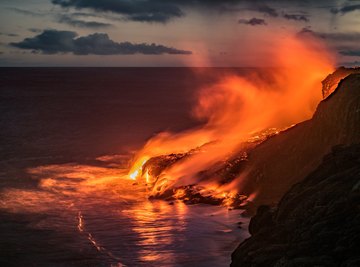
An abundance of powerful forces reside beneath the Earth's crust that can trigger earthquakes, create precious stones and erupt lava above the surface through volcanoes. Many scientists have exerted great labor to discover the structure and conditions of the Earth beneath the surface down to the planet's core. In 1913, a scientist named Beno Gutenberg contributed to the scientific community with a groundbreaking discovery regarding the inner layers of the Earth.
Earth's layers
The rocky exterior layer of the Earth, on which animals walk, is known as the Earth's crust or surface, and this layer extends down approximately 25 miles. Directly beneath the crust is the upper mantle, which is a rigid layer that consists mostly of oxygen, magnesium, silicon, iron, calcium and aluminum. Below the upper mantle is the lower mantle, in which the temperatures get substantially hotter. The mantle layers contain most of the Earth's mass and extend downward from the crust for about 1,700 miles. Beneath the mantle is the extremely hot iron-nickel core, which rests about 1,800 miles beneath the Earth's surface, is 2,100 miles in radius and is divided into two sections: an outer core and an inner core.
Gutenberg
Beno Gutenberg (1889-1960) was a scientist and seismologist who studied the inner layers of the Earth. Seismic waves are generally caused by explosions or earthquakes below ground, but in 1913 Gutenberg observed that, at a certain depth beneath the Earth's surface, primary waves slowed down dramatically and secondary waves stopped entirely. Although secondary waves can easily transmit through solid material, such waves cannot travel through liquid. Thus, Gutenberg concluded — correctly — that at the specific depth where the secondary waves vanish, around 1,800 miles beneath the surface, liquid must be present.
The Discontinuity
Because seismic waves changed their activity and secondary waves completely disappeared at the depth of about 1,8000 miles below the surface, Gutenberg was the first to discover that above this depth mark the interior of the Earth must be solid, while below this mark the interior must be liquid. Thus, Gutenberg established an accurate boundary line — or discontinuity — that separates and divides the lower mantle from the outer core. The lower mantle above the Gutenberg line is solid, but the outer core below the line is liquid molten. The actual discontinuity area is an uneven and narrow zone that contains undulations of up to 3-5 miles wide. Beneath the boundary zone, the molten outer core is much denser than the mantle above as a result of the heavy amounts of iron it contains, and below this layer is the inner core, which is composed of extremely hot solid nickle and iron.
Shrinking
Although the Gutenberg discontinuity boundary between the mantle and the core is measured at approximately 1,800 miles below the Earth's surface, this line does not remain constant. The intense heat in the planet's interior is perpetually and gradually being dissipated, which forces the molten core of the Earth to slowly solidify and shrink. Thus, the shrinking of the core causes the Gutenberg boundary to gradually sink deeper and deeper beneath the Earth's surface.
